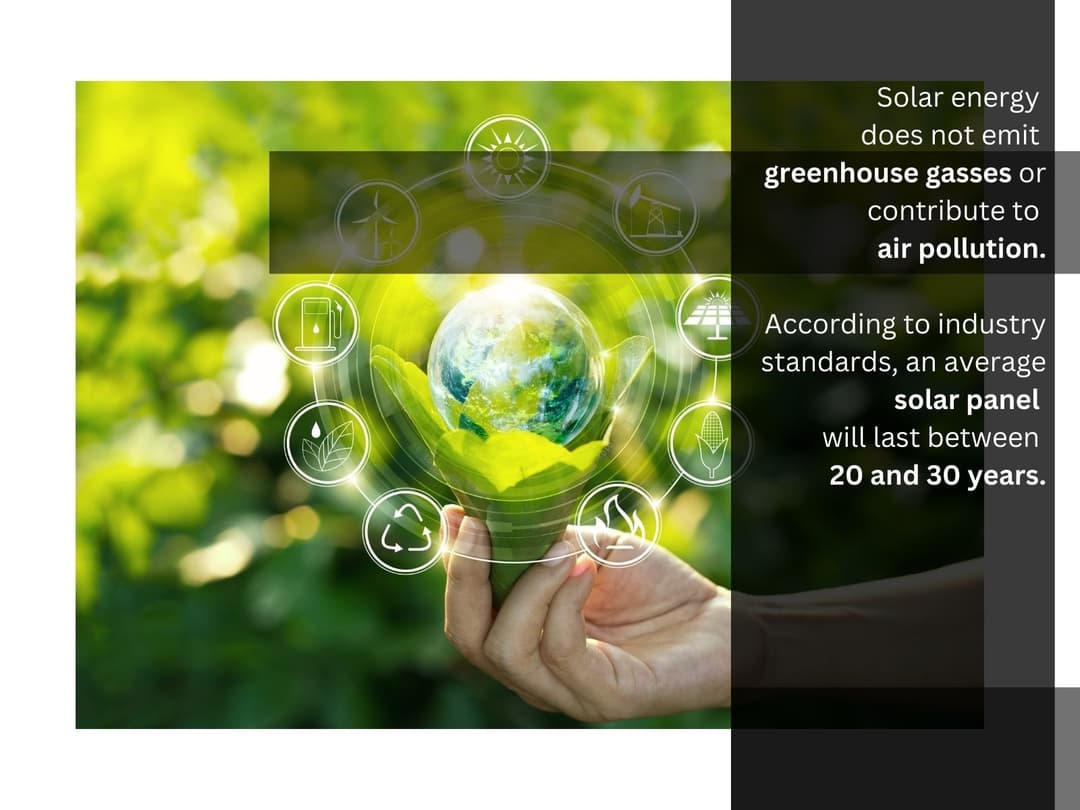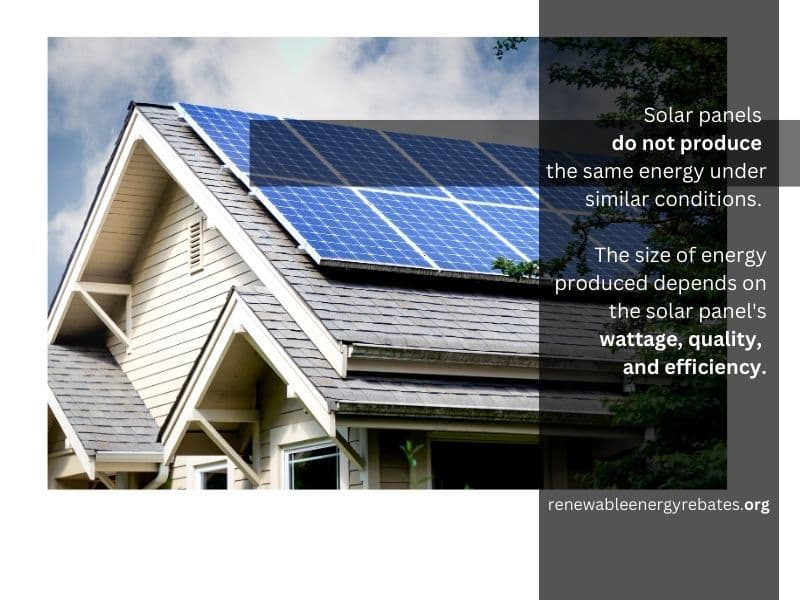Going Solar in 2023
Harnessing the Sun: Everything You Need to Know About Solar Power in the US
Key Details
- Solar energy offers benefits such as reduced electricity cost and a renewable, cleaner alternative to fossil fuels.
- Solar panels convert solar energy into electricity through a multi-step process involving DC to AC conversion.
- Solar energy does not emit greenhouse gasses or contribute to air pollution.
- An average solar panel has a lifespan of between 20 to 30 years with an efficiency rate dropping by 0.5 after 20 years.
What is Solar Energy?
In simple terms, solar energy is the light and heat energy emitted from the sun's surface. This energy can be harnessed to power photovoltaic systems (solar panels) to create electrical energy.
Solar power has progressed rapidly from a laboratory experiment to an alternative to fossil-based fuels.
Edmond Becquerel is credited with discovering solar energy in 1839. He discovered that some materials can generate electricity when exposed to sunlight. A hundred years after the discovery, Russell Ohms created the modern-day solar cell designs.

So, how does solar power work?
Here's a step-by-step guide on how your solar panels convert solar energy into solar power.
Step 1: Solar energy hits the solar cells.
Each solar cell has a thin layer of silicon, which is a semiconductor. The sun's rays activate the electrons in the silicon atoms and cause them to move, resulting in electric current. This current is then transported to an inverter.
More electrons become activated during peak sunlight hours. Peak sunlight hours are when the solar radiation is highest. Some US states have more peak hours than others. For example, Arizona has 3,806 hours of peak sunlight every year.
Step 2: Conversion of DC current to AC
Solar panels produce direct current (DC), which is not suitable for your residential or commercial energy consumption. Your home appliances or office equipment run on alternating current (AC).
However, solar installations also come with an inverter, which converts DC to AC.
In solar installations, you have two options:
- Choose a solar panel that has micro-inverters attached behind each panel.
- Choose a solar panel that comes with a separate inverter. This inverter is usually installed near your circuit breaker.
US solar users can also invest in hybrid inverters or power optimizers. Also, some inverters connect to the internet and provide you with all the necessary data, from usage to energy efficiency.

Step 3: The AC current moves through the circuit breakers
The circuit breakers are a last line of defense to protect your appliances from power surges. So, the AC current moves through the circuit breaker to different sections of your home. In addition, it connects to a net meter, which measures how much electricity you receive from the solar system and from the electric grid.
Solar systems are an effective and affordable power solution in the US. It's no surprise that the US generates an average of 146 billion kWh from solar installations. Furthermore, solar power constitutes about 3.4 percentof the total renewable energy generated. Here's a further breakdown of the percentage of energy sources consumed in the US.
| Energy source | Billion kWh | Share of total |
| Fossil Fuel | 2,554 kWh | 60.2% |
| Nuclear | 772 kWh | 18.2 |
| Renewable Energy | 913 kWh | 21.5% |
What are the Different Types of Solar Energy?
The different types of solar energy in the US include:
- Solar photovoltaic system
- Passive solar
- Solar thermal systems
- Concentrated solar power
Solar Photovoltaic
Photovoltaic is the most common type of solar power. It simply involves using solar cells to capture light energy from the sun. These electrons in the solar cells become activated when exposed to light. Furthermore, the movement of electrons generates electricity.
Bells Labs in the US perfected the first efficient photovoltaic system in 1954. A few years later, this system became popular in small-scale applications, such as solar-powered calculators and watches. The energy crisis of 1970 further expanded the usage of PV systems in residential and commercial facilities.
Here are the common types of photovoltaic systems you'll find in the US:
- Thin-film solar cells
- III-V Solar cells
- Organic or hybrid-organic solar cells.
Passive Solar Heating
Passive solar heating provides a cost-effective way of generating heat in residences and commercial facilities. It involves the conscious use of architectural designs to capture heat energy from the sun.
Passive solar can generate heat and also cool down heat in living spaces. Here are some of the common methods for using passive solar in residences and commercial facilities:
- Install glass windows facing 30 degrees true south. Furthermore, keep the windows open between 9am and 3pm
- Use building materials like concrete, tiles, bricks, and stone. These materials absorb heat during the summer (when the outside temperature is high). Also, it absorbs and retains heat in interior spaces during cold or cloudy days.
Note: A well-optimized passive solar heating system can generate up to 40 percent of the heating requirements for a property.
Solar Thermal Systems
Solar thermal systems absorb heat energy from the sun and use it to heat water in homes and commercial facilities. It is one of the most cost-effective ways of using solar energy.
Since 2010, the US has installed over 35,464 solar water heating systems. It generates heat for swimming pools during cold weather conditions.
A solar thermal panel is quite similar to that used in PV systems. But the system depends on water to move heat from the panel to a cylinder that heats water. Hot water moves to a water heater cylinder, while cold water moves into the panel to continue the process.
Concentrated Solar power
The concentrated solar power system is a new method of generating electricity via heat energy from the sun. It uses the same principle as steam engines, in which heat is used to spin huge turbines. The turbines will, in turn, drive generators that produce electricity. Here are the main types of concentrated solar power in the US.
- Linear concentrator systems
- Power tower systems
- Dish engine systems
Is Solar Energy Renewable?
Solar energy is a renewable energy source. It is regarded as a renewable energy source for these reasons:
- It derives energy from the sun, which is a natural resource that can never be depleted.
- It does not cause direct harm to the environment.
- It does not generate carbon which depletes the ozone layer.
Renewable energy is loosely defined as energy from natural resources that can not be depleted. Solar energy is not the only renewable energy source that's accessible to US residents. You can also harness alternatives like biomass, wind, and hydropower. Geothermal energy is also another renewable energy source.
What are the Benefits of Solar Energy?
As of 2022, 3.7% of single-family homes and 1.6% of commercial buildings had installed solar systems. More residences and commercial entities are adopting solar power for these reasons:
1. It reduces the cost of electricity
Most users think PV systems are too expensive to install. However, these installations are actually cheaper when you consider the long-term return on investment. US solar users can save up to $1,500 a year on electric bills.
More so, you can save between $20,000 and $90,000 over the lifespan of your PV systems. Interestingly, most solar panels still function effectively after their 25-year lifespan.
2. It is a cleaner alternative to fossil fuels
According to the EIA, fossil fuels are a leading source of pollution and other health hazards in the US. For example, CO2 emissions are responsible for the global warming phenomenon. For this reason, switching to solar power will reduce your carbon footprint and improve your environment.
3. It offers passive income opportunities
In most US states, you can earn money by generating excess solar energy through the net metering program and other state-specific services. To earn via net metering, you must connect to an electric utility company and install a net meter. The company will pay in energy credits for any excess power generated. Some users may convert these credits to cash amounts after a specific period.
Note: Electric utility companies also offer additional incentives.
4. It offers tax incentives at the state and federal level
Solar users are eligible to receive federal and state tax incentives. For example, the federal solar tax credit offers a 30 percent discount off the cost of solar installation. Solar users can receive the discount as a tax credit when they file their annual income tax. Some US states also offer property tax and sales tax exemptions to commercial and residential solar users.
5. It increases the property value
According to a Berkeley Lab report, a typical PV system increases a property's value by $15,000. Also, home buyers paid $4 per watt of solar panels installed on properties.
What are the Main Disadvantages of Solar Energy?
Despite the teeming benefits of solar power, there are a few downsides you need to know.
1. It is expensive to install
Solar energy has a very high cost of installation. The average cost of a 6 kWh PV system can be as high as $18,000 in some states. No doubt, the cost is above the financial capacity of most low- to middle-income earners.
2. It does not function well in bad weather conditions
A few cloudy days and a cold winter period are enough to reduce the efficiency of your solar systems. Performance is low during these periods, and you may need to depend on grid electricity.
Also, solar power systems are unable to absorb solar energy at night. This means you only have a few hours a day of peak sunlight to gather solar energy.
3. Solar batteries are expensive
Solar batteries are the smart choice if you need energy during bad weather conditions. Unfortunately, it is beyond the financial capacity of some solar [pwer users. The average cost of a residential lithium-ion solar power battery is between $7,000 and $14,000.
4. It takes up much space
This is a major downside for those living in shared residential buildings. The higher the energy output, the more solar panels you need to install. This means you need more than just a good location; you also need enough open space to install the panels. Roof-mounted installations can also reduce the lifespan of the roof.
How Clean is Solar Energy?
Solar energy does not emit greenhouse gasses or contribute to air pollution. However, it is not a completely "clean" energy source. The solar manufacturing processes require the use of harmful and toxic chemicals like sulfuric acid, arsenic, and hydrogen fluoride. Some solar panels also use heavy metals, which may cause untold damage if they are not disposed of properly.
Do Solar Panels Work at Night?
Solar panels do not work at night since they need sunlight to function. For this reason, most solar users switch to grid electricity or use energy from solar batteries at night. Solar users can use the energy credits in a net meter to pay for using grid electricity.
Do Solar Panels Need to be Cleaned?
Yes, it is recommended to clean the surface of solar panels three or four times a year. Dust, animal droppings, dead leaves, and branches can reduce the efficiency of your solar panel. Once you notice a drop in solar energy output, it may be time to clean the panels. Don't use a pressure washer since it damages the cell surface. Use soapy water and a non-abrasive sponge to remove the debris.
How Long Do Solar Panels Last?
According to industry standards, an average solar panel will last between 20 and 30 years. After a 20-year benchmark, the efficiency rate will fall by 0.5 every year. Keep in mind that some panels still retain about 90 percent efficiency after the standard lifespan.